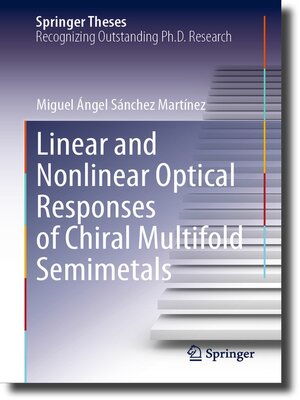Linear and Nonlinear Optical Responses of Chiral Multifold Semimetals
ebook ∣ Springer Theses
By Miguel Ángel Sánchez Martínez

Sign up to save your library
With an OverDrive account, you can save your favorite libraries for at-a-glance information about availability. Find out more about OverDrive accounts.
Find this title in Libby, the library reading app by OverDrive.



Search for a digital library with this title
Title found at these libraries:
| Library Name | Distance |
|---|---|
| Loading... |
Since the initial predictions for the existence of Weyl fermions in condensed matter, many different experimental techniques have confirmed the existence of Weyl semimetals. Among these techniques, optical responses have shown a variety of effects associated with the existence of Weyl fermions. In chiral crystals, we find a new type of fermions protected by crystal symmetries — the chiral multifold fermions — that can be understood as a higher-spin generalization of Weyl fermions.
This work provides a complete description of all chiral multifold fermions, studying their topological properties and the k·p models describing them. We compute the optical conductivity of all chiral multifold fermions and establish their optical selection rules. We find that the activation frequencies are different for each type of multifold fermion, thus constituting an experimental fingerprint for each type of multifold fermion.
Building on the theoretical results obtained in the first partof our analysis, we study two chiral multifold semimetals: RhSi and CoSi. We analyze the experimental results with k·p and tight-binding models based on the crystal symmetries of the material. We trace back the features observed in the experimental optical conductivity to the existence of multifold fermions near the Fermi level and estimate the chemical potential and the scattering lifetime in both materials.
Finally, we provide an overview of second-order optical responses and study the second-harmonic generation of RhSi. We find a sizeable second-harmonic response in the low-energy regime associated with optical transitions between topological bands. However, this regime is extremely challenging to access with the current experimental techniques.
We conclude by providing an overview of the main results, highlighting potential avenues to further research on chiral multifold semimetals and the future of optical responses as experimental probes to characterize topological phases.







